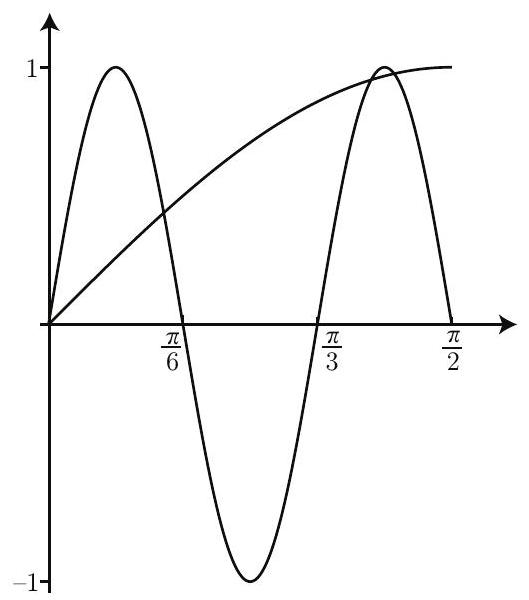Problem:
For how many values of x in [0,π] is sin−1(sin6x)=cos−1(cosx) ? Note: The functions sin−1=arcsin and cos−1=arccos denote inverse trigonometric functions.
Answer Choices:
A. 3
B. 4
C. 5
D. 6
E. 7
Solution:
Let f(x)=sin−1(sin6x) and g(x)=cos−1(cosx). If 0≤ x≤π, then g(x)=x. If 0≤x≤π/12, then f(x)=6x. Note also that sin(6(6π−x))=sin6x,sin(6(3π−x))=−sin6x, and sin(6(3π+x))= sin6x, from which it follows that f(6π−x)=f(x),f(3π−x)=−f(x), and f(3π+x)=f(x). Thus the graph of y=f(x) has period 3π and consists of line segments with slopes of 6 or -6 and endpoints at ((4k+1)12π,2π) and ((4k+3)12π,−2π) for integer values of k. The graphs of f and g intersect twice in the interval [0,6π] and twice more in the interval [3π,2π]. If 2π<x≤π, then g(x)=x>2π, so the graphs of f and g do not intersect.
OR
In the range [0,π], we have cos−1(cosx)=x. Since the range of sin−1x is [−2π,2π], it suffices to solve the equation sin−1(sin(6x))=x on the interval [0,2π]. Since sinx is one-to-one in [0,2π], we can consider the equivalent equation sin(sin−1(sin(6x)))=sinx, or sin(6x)=sinx. Let f(x)=sin(6x) and g(x)= sinx. Note that f(0)=0,f(12π)=1,f(4π)=−1,f(125π)=1, and f(2π)=0. Moreover f(x) is increasing on (0,12π) and (4π,125π), and decreasing on (12π,4π) and (125π,2π). Similarly g(0)=0,g(2π)=1, and g(x) is increasing on [0,2π]. Thus the graphs of y=f(x) and y=g(x) intersect at x=0, once in the interval [12π,4π], once in the interval [4π,125π], and once more in the interval [125π,2π]. Therefore there are 4 solutions to the given equation.
The problems on this page are the property of the MAA's American Mathematics Competitions
